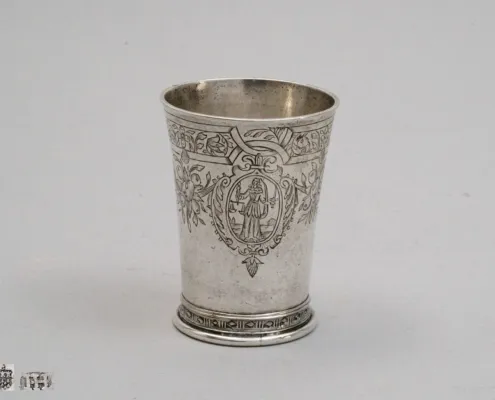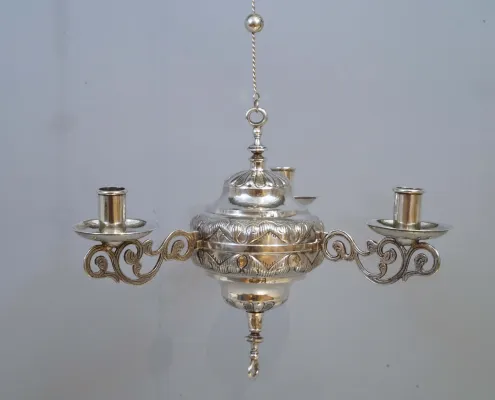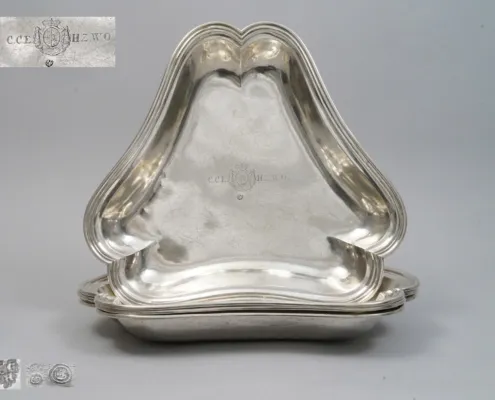SILVER ON THE GO
„TRAVEL, IN THE YOUNGER SORT, IS A PART OF EDUCATION, IN THE ELDER, A PART OF EXPERIENCE” | FRANCIS BACON, THE ESSAYS – OF TRAVEL (1625)
Travelling is an activity that human beings love to undertake. In different eras, the significance of the travel takes however different dimensions. On the above-mentioned quotation of Francis Bacon, travelling in the early seventeenth century is thought to be an important part of a man’s life, especially for his education and his overall experience. However, men were travelling since the Antiquity and throughout the Middle Ages: for economic reasons (e.g. merchandising), for conducting wars and expanding empires (e.g. the foundation of colonies) or for pilgrimage (e.g. Christians going to Jerusalem).
INTERESTING NEW ACQUISITIONS
Historical Context of Travelling
Tokens of the experiences during the travelling adventures of a Renaissance and an early seventeenth-century European are several objects of the material and table culture. These can be for instance representative drinking vessels made from materials such as coconut or nautilus shells. Other objects of the dining culture, which often have a representative function, are those that take the form of ships made of silver. Those are made since the Middle Ages, have a symbolical use and often represent in an ideal or freely-artistic way how people undertook their journeys. Particularly during the seventeenth century, Europeans were quite active in trading with Asia, Africa and parts of the New World, so that travelling became an established habit. Influences on the diet, like the regular consumption of coffee and tea in Europe, reflect the impacts of journeys on different aspects of life.
A new era for travelling appears with the eighteenth century. The century of the Enlightenment raises travelling to a very important activity for the young members of aristocratic and noble families across Europe when reaching adult age. Intellectual, cultural, artistic and scientific interests were closely bound to these journeys. Every young man – but also sometimes women (see e.g. Lady Mary Wortley Montagu) – should visit places like Italy and even Greece and other places of the Ottoman empire, like Istanbul/Constantinople. These journeys took the name of “Grand Tour”. By this, it was meant that people undertook long journeys, passing through every possible, interesting city of the European continent and having as destination the Italian peninsula and even further. All this is connected to the development of modern scientific disciplines like Archaeology and Art History but also to the search of the Western civilisation’s roots.
In the nineteenth century, there is an abundant production of books giving advice on how one can travel in a safe and comfortable way. These testify that the Grand Tour was still an activity en vogue, especially if one considers the evolution in the means of transportation. Among the published guides on this matter, there is also a traveller’s guidebook written by William Kitchiner and published around 1828 (third edition), entitled Traveller’s Oracle or Maxims for Locomotion. The author advises the travellers among many other things to bring their own knife, fork and spoon with them. He characterises that as a “no small comfort” (Kitchiner 1828, p. 71), a declaration that says a lot on the conditions that still prevailed in eateries in the UK and continental Europe in the early nineteenth century.
This information is of interest with regards to the relation of antique silver and silver productions to the activity of travelling. The connection is not at once obvious and the title of some objects like for instance “travelling necessaire” can be sometimes misleading. Let us explore in closer detail how exactly antique silver is connected to travelling and to some objects made of silver.
Travel and “Travelling Necessaires”
Our focus here is on this complex object of the early modern era called “travelling necessaire” or “etui” or “case”. This means shortly a case, which can be transported and which contains the most necessary objects for the travel (the necessaries or “nécessaires” in French). These were most often made by precious materials like silver, gold, porcelain, glass and other. Travelling necessaries, although of an older origin, became a kind of a mirror of the commercial and social habits of the eighteenth century. The popularity of the Grand Tour within the upper classes and noble or the fact of being away on diplomatic and military missions, increased the demand for travelling necessaires. Moreover, such cases were offered as a gift – from a man to a woman and vice-versa. These necessaires are thus sometimes more witnesses of the sumptuous life-style in the eighteenth century than objects that were used.
Travelling necessaires – in French “nécessaires de voyage” – have a long history in continental Europe and notably in France. They appear in written sources since the late fourteenth century, while in the sixteenth century, Francis I of France (1494-1547) owned such an object of an astonishing quality. The word used for them in French was initially “étui”. Since the seventeenth century, the preferred wording for such objects was “cassette”. In the first quarter of the eighteenth century, the new word used was “nécessaire” (in a letter of the duchesse d’Orléans in 1718).
The name „nécessaire de voyage” is thus rather given and used since the early eighteenth century. The theatre author Beaumarchais even mentions such an object in his play The Barber of Seville (1775): “Bartolo, criant: Qu’est-ce aue j’entends donc? Le cruel barbier aura tout laisse tomber par l’escalier, et les plus belles pièces de mon nécessaire !… » (III act, scene V). Such cases, used for sets made for drinking coffee, tea and chocolate while on travel, they were quite often mentioned in dictionaries of their time as “furniture” (“meubles”). However, their increased popularity throughout the eighteenth century enriched their character. They gradually contained a selection of toilet articles, writing equipment, cutlery and other items for several uses. The number of their forms, their contents and their uses was very rich throughout this century and merchants sold them in abundance.
Such a case presented by Helga Matzke, made for Margravine Philippine Auguste Amalie of Brandenburg-Schwedt (1745-1800), shows the great popularity and the different functions that these objects continued to have at the turn of century.
The Three Major Functions
Three major functions can be attributed to such travelling necessaires: portability, representation and gift. Portability is praised in the nineteenth century (s. e.g. Kitchiner 1828, p. 100-1) but it is defined since the Middle Ages. Throughout the Middle Ages, it was a habit to store household goods in boxes, which would also serve as transport methods during travelling (s. for e.g. in the collections of The MET). Although relatively rare, in the late seventeenth century, there are also some clocks – with integrated alarms and calendars – adapted for the life on the road (s. a rare example of the British maker Joseph Paulet in The MET). Thus, such portable cases contained several necessary objects for the daily life, which were used both within and away from home.
The second major function, that of representation, is mostly testified by the habits of the upper and aristocratic class of the eighteenth century. The ceremonial custom of levée (from the French se lever, rising) was an intimate moment in the daily life, initially of the monarch or of a leader. He would accept close-related visitors to his process of getting dressed for the day. This was a time when partially important discussions were made. This ceremony became gradually popular to other aristocratic circles and won an essential role in the courtly life. For this moment of importance, when a person would show his/her status quo, surrounding objects had a representative role. This is where the so-called “necessaries” become relevant, since both men and women held their toilet objects and accessories made of silver and other precious materials in their cases made for them. These were the personal, central showpieces.
With what has been until now mentioned, it becomes obvious that the so-called travelling necessaries is a rather generic term. In this sense, it is referred to matched ensembles of objects – very often of a high level of artistic design and quality of execution. These objects might have been cases prepared by the makers or merchants, without any placed order. On the other hand, they were often made after commission. At last, they were sometimes put together after a placed order in a rather quick way, using objects made by different makers. Travelling cases are thus divided in under-categories: for coffee and tea, for writing, for eating, for the ladies’ toilet, and so on.
All of the above brings us to the third major function of such cases, that of being offered as a gift. This function is connected to the custom in central Europe (mostly France and Germany) of offering gifts to young mothers on the birth of their first child. These gifts were mostly bowls, known as “bouillon d’accouchée” [= soup of a woman who has recently given birth], usually accompanied by a cover and a salver. These were often only show pieces. The equivalent in the English Silver is the “caudle cup” – from the caudle provided to women who had just given birth. Toilet necessaires or just necessaires were also offered as a “morning gift” for the next day of the wedding night. In the eighteenth century, marriages were mostly arranged and were acts with political consequences, thus formal gifts were also quite important.
Augsburg specialised in the production and coordination of silver table services, toilet necessaires and similar objects. Helga Matzke has an impressive travelling necessaire of the late seventeenth century made in Augsburg, showing the great level of craftsmanship and beauty that could have fulfilled this function.
Last but least, one should not miss to note that such precious objects have been always considered as a safe investment for women, since they could always sell or melt down the silver and gold objects to gain quickly money if needed.
Expertise and Craftsmanship
Besides their multiple functionality, travelling necessaires represent master works produced by a series of specialised craftsmen: cabinetmakers, goldsmiths, mirror manufacturers and leather goods manufacturers – to name only a few. They managed to produce splendid objects, full of expensive and noble materials and finally put in elaborated wooden cases that contained as much objects as possible in an as much small as possible space.
Martin-Cuillaume Biennais (1764-1843), originally active as a cabinetmaker and manufacturer of small objects in the rue Saint-Honoré in Paris, won his great reputation as a silversmith especially after the French Revolution (after 1789). During the Consulate and Empire for instance, Biennais had supplied Napoleon and members of his family various types of nécessaires. A very fine example of such a necessaire made by Biennais is to be seen in the Schatzkammer of the Residency in Munich, the travelling case of the Empress Marie-Louise presented by the city of Paris in 1810 on her marriage to Napoleon.
Besides Paris, in other French cities with a long tradition in the production of silver and gold works, there was a considerable production of such travelling necessaires. We are very excited to be able to show a wonderful case made in Strasbourg. It is a piece from the last quarter of eighteenth century and of an excellent quality. This necessaire shows many small details (like the pearl-ring on the cover being left in white silver) that emphasize the expertise of the maker and the detailed work of the cabinetmaker, while on the same time praise the person – most probably a woman – to whom it was offered.
This “tour” in the world of the material culture of travel could only point out the most important aspects of travelling necessaires made with silver objects. Explore the variety we show online and keep in touch with us, in case you would like to learn more!
Selected Literature
Heitmann, Bernhard, Die deutschen sogenannten Reise-Service und die Toiletten-Garnituren von 1680 bis zum Ende des Rokoko und ihre kulturgeschichtliche Bedeutung, Hamburg 1979 [Ph.D. diss., Univ. of Munich].
Havard, Henry, Dictionnaire de l’ameublement et de la décoration : depuis le XIIe siècle jusqu’à nos jours, Bd. 3, 1894, Maison Quantin : Paris, S. 1075-1082.
Huber-Yüzgec, Christina, ‘Begleiter für alle Fälle: Toilettengarnituren und Reisenecessaires im Wandel der Zeit’ In: Wiese, Woflgang und Schröck-Schmidt, Wolfgand (Hrsg.), Das Stille Örtchen: Tabu und Reinlichkeit bey Hofe, Berlin-München: Deutscher Kunstverlag/Staatliche Schlösser und Gärten Baden-Württemberg, 2011.
Poole, Julia, ‘Princess Pauline Borghese’s Nécessaire de Voyage’ in The Connoisseur, Oct. 1978, vol. 199, pp. 107-113.
Truman, Charles, ‘A St. Cloud Nécessaire de Voyage circa 1750’ in The Connoisseur, April 1980, vol. 203, Nr. 818, pp. 253-5.
Wittmann, Otto, ‘A Great Lady’s Nécessaire de Voyage’ in Apollo, 1971, vol. XCIV, Nr. 114, pp. 145-9.
Hessische Hausstiftung/Museum Schloss Fasanerie (eds.), Silber auf Reisen, Sonderausstellung 1991/92, Fulda.






